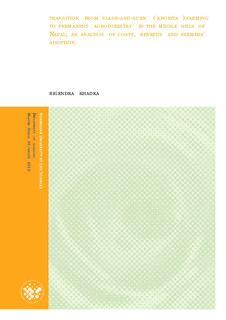| dc.description.abstract | Slash-and-burn farming, locally known as Khoriya farming, has been one of the farming systems prevailing in the middle hills of Nepal. Reduced fallow period in this kind of agriculture is considered as the major economic downturn of the cultivators and environmental hazards in the area. Despite of these negative consequences, farmers are practicing Khoriya farming because of lack of alternative, poverty and government’s negligence over the issue. Against the backdrop, MDI-Nepal (Manahari Development Institute), a non-government organization, started agroforestry program for Khoriya farmers in Makwanpur district of Nepal. The aim of this paper was to analyze the costs and benefits and the adoption of introduced agroforestry system and the traditional Khoriya farming prevailing in the area. Net present value (NPV), benefit- cost ratio (B-C ratio) and return to labor were the major financial indicators to analyze the costs and benefits of two systems to
farmers. Binary logistic regression model was used to analyze the effects of various factors on agroforestry adoption by Khoriya farming households. Moreover, farmers’ perceptions over advantages and disadvantages of agroforestry and motivational factors for adoption were
also studied. The data of the study came from household survey with randomly selected 218 farmers (109 with agroforestry and 109 with Khoriya farming) and two focus group discussions in four VDCs ( Village Development Committee) of Makwanpur district in Nepal. Results of the farm income analysis showed that agroforestry system was financially
profitable than the traditional Khoriya farming in the area. All three indicators of financial analysis; NPV (Net present value), B-C (Benefit-cost ratio) ratio and return to labor was higher in agroforestry system than Khoriya farming. The binary logistic regression predicted that education level of the household head, extension services, presence of active labor in household, average off- farm income were positively related to the adoption of agroforestry
among Khoriya farmers. Younger farmers who were nearer to market centers were the early adopters of the agroforestry system. Similarly, the selection of species was the crucial motivational factors to adopt agroforestry system in contrary lack of capital and complex management system in view of farmers were the most limiting factors for the adoption of
introduced agroforestry system in the area. Findings of the study suggest that the introduced agroforestry can improve the economic status of slash-and-burn farmers and ecological stability of the area only if establishment costs are subsidized and land tenure problems are solved. | en_US |
